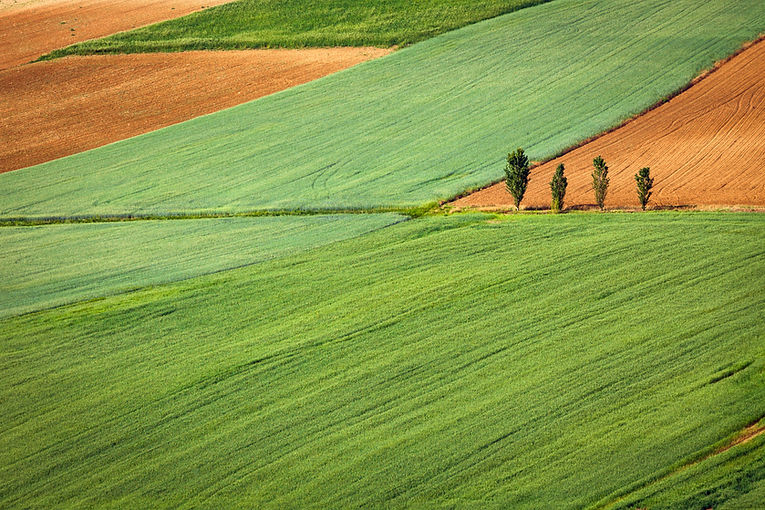These are the bands that farmers should like
- Adriaan van Niekerk

- Nov 1, 2018
- 3 min read
Updated: Nov 10, 2018
In an earlier article I explained that remote sensing – within the context of earth observations – is the practice of deriving information about the earth’s land and water surfaces from afar. In most cases information is obtained by studying, interpreting and analyzing photographs (images) acquired from an overhead perspective.
Typically, fancy cameras (called passive sensors) are mounted on satellites, airplanes or drones to record sunlight (electromagnetic radiation) reflected or emitted from the earth’s surface. Most of these sensors are capable of capturing blue, green and red (RGB) light, mainly because different mixtures and intensities of these so-called primary colors can be used to represent all the (secondary and tertiary) colors in the rainbow (see diagram below).

Many of the sensors used in remote sensing are also sensitive to “colors” or regions (called bands!) in the electromagnetic spectrum that are not visible to humans. A good example of such a band is infrared – the same light transmitted by many remote control devices.
As with visible light, infrared radiation is subdivided into three primary regions, namely near-, mid- and far-infrared. Here the adjectives describe the similarity of the wavelengths to those in the visible spectrum. Near-infrared (NIR) radiation has slightly longer wavelengths than visible light, while the wavelengths of far-infrared radiation is much longer than visible light.
Being able to record infrared radiation is very useful for earth observations as many objects on the earth’s surface have similar colors (i.e. have similar absorption properties in the visible spectrum), but reflect infrared radiation differently.
For instance, a tennis court and a grass soccer (football) pitch are both green, but a paved tennis court would typically reflect less NIR radiation than a soccer pitch (because vegetation strongly reflects NIR radiation). Such differences help to discriminate between objects on the earth’s surface, which is integral to image interpretation and classification. NIR is my favorite band by far! (Although U2 is also pretty good!)
Mid-infrared wavelengths – also called short-wave infrared (SWIR) to confuse you – are useful for studying differences in moisture, because such radiation is strongly absorbed by water. Being able to quantify differences in moisture is, of course, very useful in agriculture as it can help to schedule irrigation and identify areas within fields that are waterlogged. The infographic below shows how the combination of the red and NIR bands (top row) can differentiate growth vigor within vineyards, whereas the combination of NIR and SWIR bands (bottom row) emphasize differences in moisture.
Far-infrared radiation is almost entirely absorbed by the earth’s surface. As such much of it is emitted in the form of heat, or thermal energy, rather than being reflected by objects on the earth’s surface (as with shorter wavelengths). Imagery with thermal infrared bands are generally less common than those with visible, near- and mid-infrared bands because thermal sensors require cooling systems and insulation to reduce the impact of ambient temperatures on recordings. It is a pity, because such imagery is very useful to monitor land surface temperatures (LST) or to model processes such as the amount of water used by plants (evapotranspiration).
Most cameras affixed to drones – or unmanned aerial vehicles (UAVs) –
only record images in the RGB part of the electromagnetic spectrum. They thus have limited value for agricultural applications. Some of the more advanced (expensive) drone sensors can also record reflectance in the NIR spectrum, which is of much more value as it can be used to study vegetation vigor and health. Very few drone sensors are capable of recording SWIR or mid-infrared radiation, simply because these sensors are typically are big and heavy. Although some drones can carry bigger payloads, the high cost of SWIR sensors is also a limiting factor.
Similarly, many satellite sensors (e.g. SPOT 6/7, RapidEye, GeoEye) only record in the visible and NIR parts of the electromagnetic spectrum. Notable exceptions are the latest WorldView, Landsat and Sentinel-2 sensors, which have several NIR and SWIR bands. Of course, the spatial resolution (smallest objects that can be detected) of satellite sensors is generally much lower than what a drone can provide, but that is a topic for a different article.
To conclude, various electromagnetic bands are used in remote sensing and each of these are useful to highlight certain characteristics of the things on the earth’s surface that we are studying. For agricultural purposes, the minimum requirement for a sensor is that it be capable of recording RGB (visible) and NIR radiation. So next time someone wants to sell you imagery, ask them whether it includes the NIR band. Preferably it should also include a SWIR band, depending on the purpose of the imagery.
This article was originally published on www.remotesensing.blog, which is devoted to articles about the use of remote sensing and other geospatial technologies for agricultural and related applications.
See related posts:














Comments